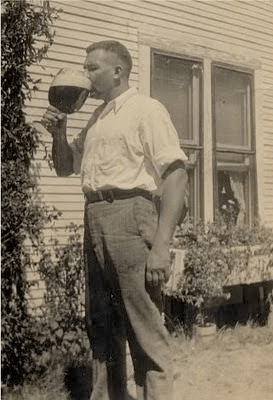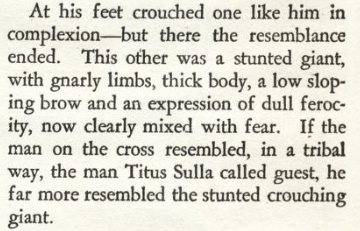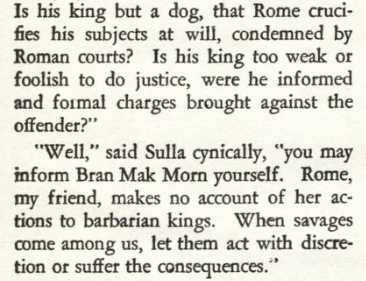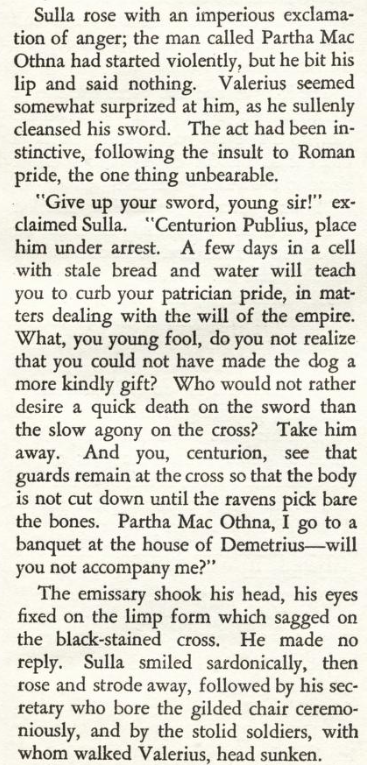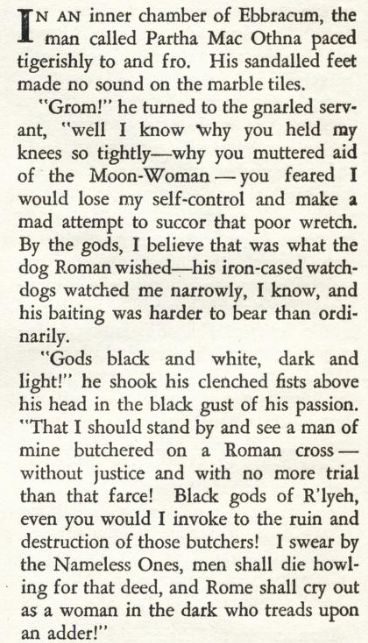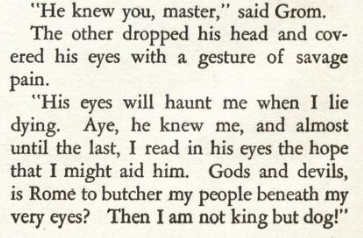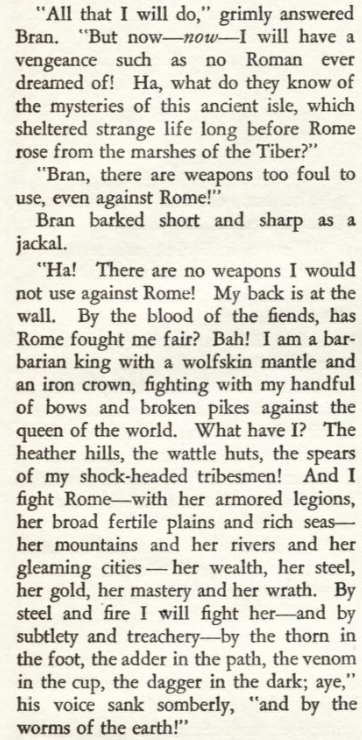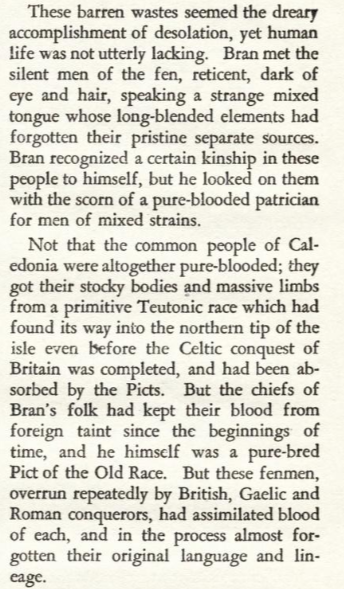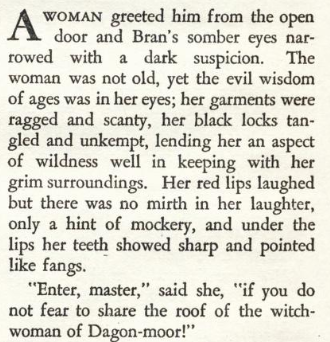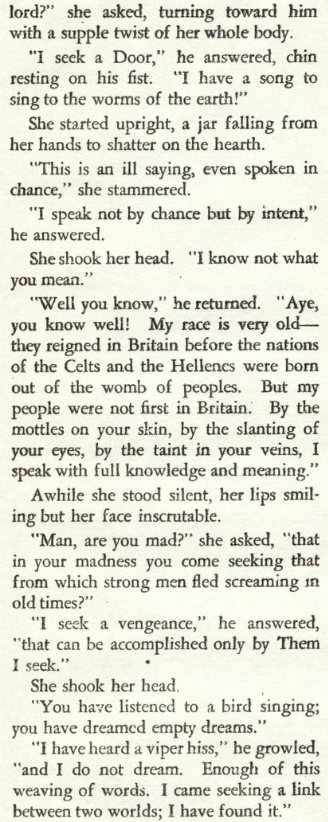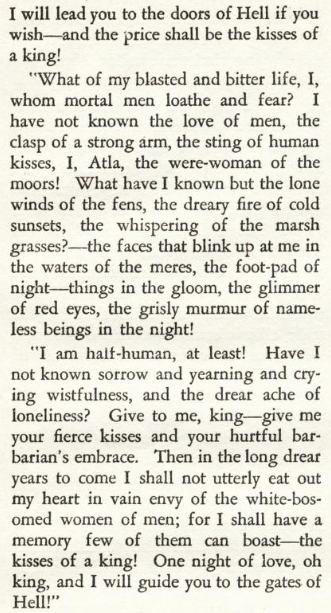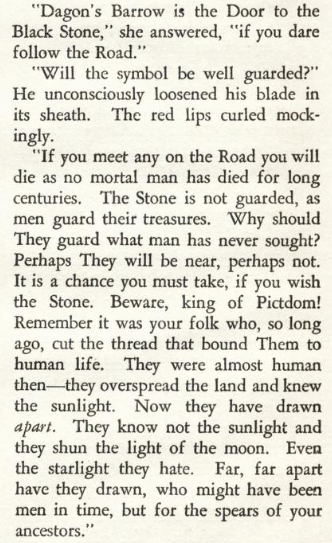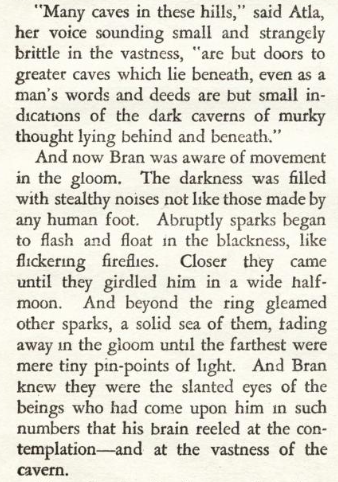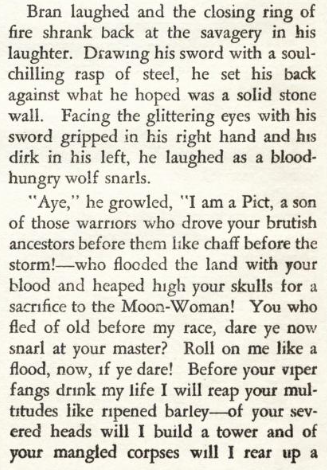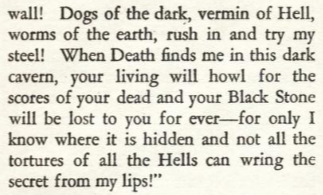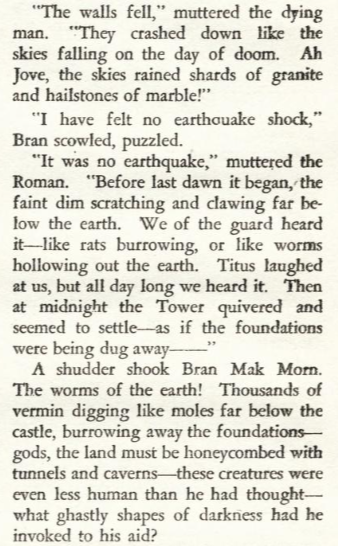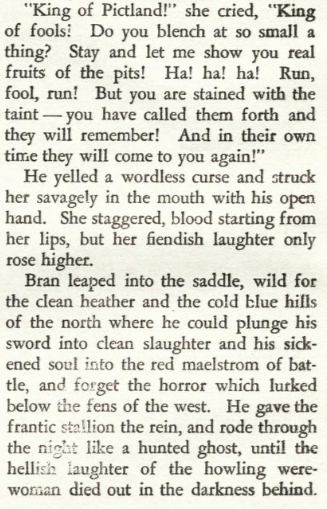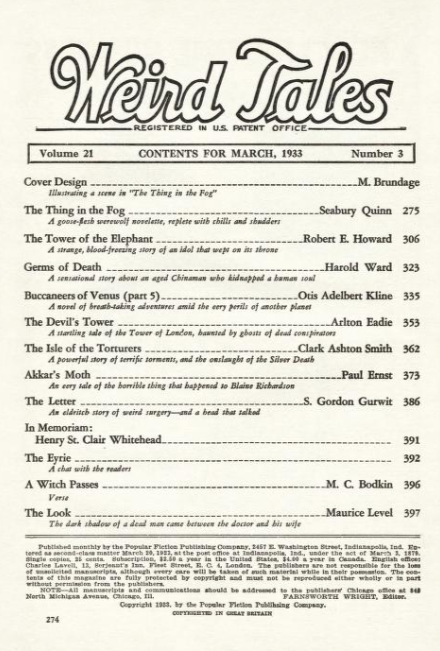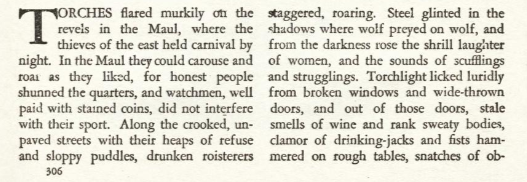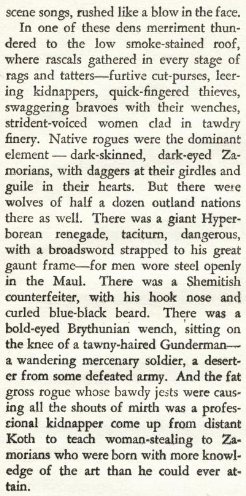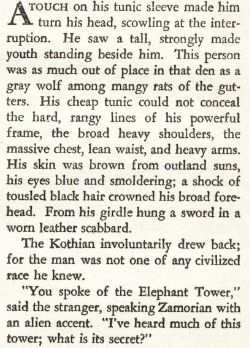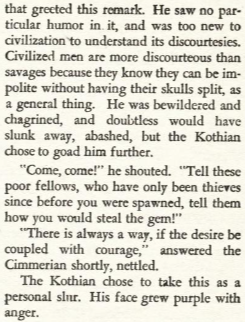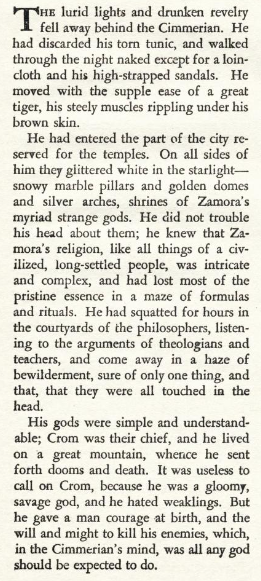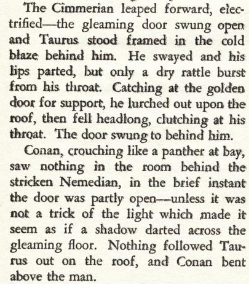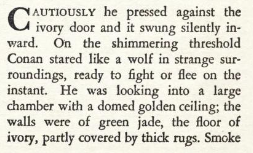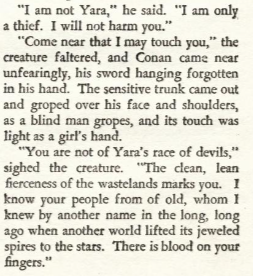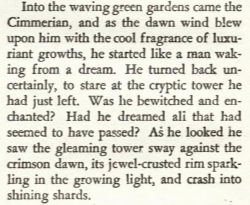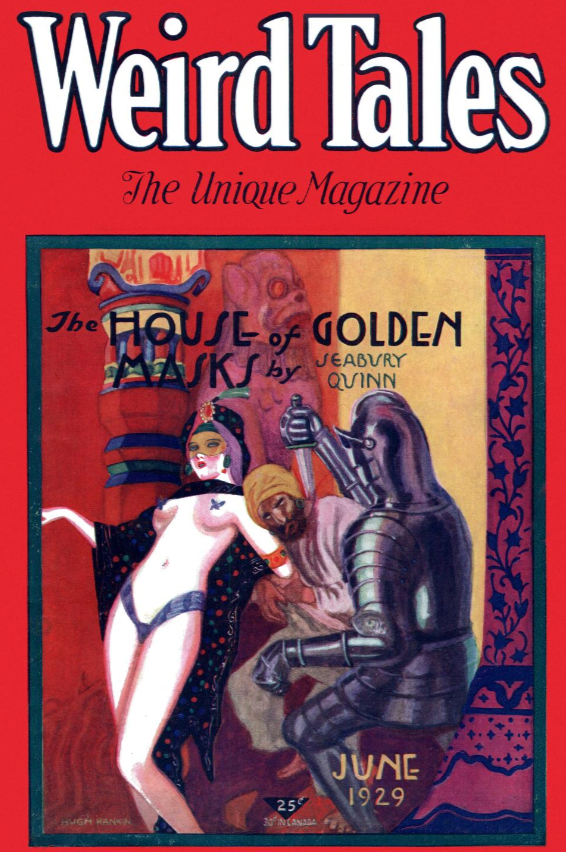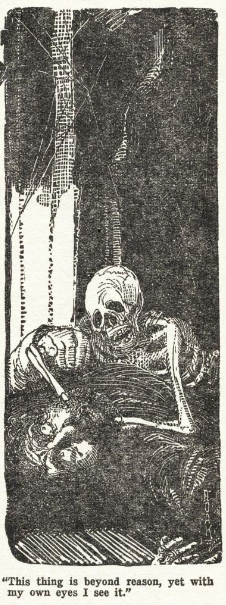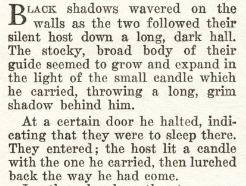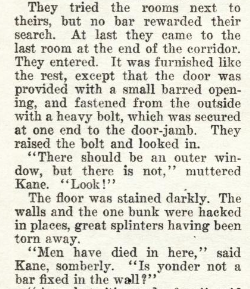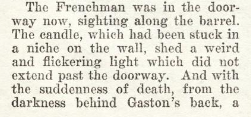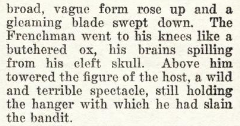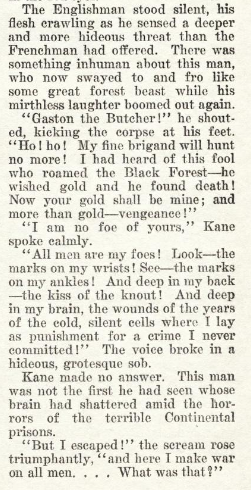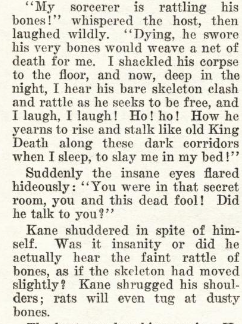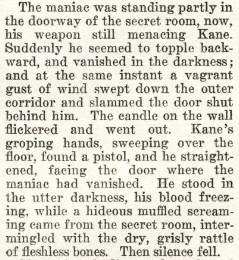In the “Thief of Forthe” discussion, I posted Clifford Ball’s brief encomium to REH from The Eyrie, Weird Tales‘s enormously important and incredibly interesting letter section, where readers, writers, and editors wrangled with Weird Fiction and discussed the stories, characters, and aesthetics of the genre. It’s an interesting little letter, mostly because it explicitly couches Howard’s death in terms of the loss of stories that readers would never see (one of the most gratifying types of mourning a writer can imagine, honestly). And ol’ Ball wasn’t alone – Howard’s death really rocked the Weird Tales readership, and elicited a lot of shocked and saddened letters from a lot of fans.
What’s fun about ’em, though, is that these letters offer a really interesting ground-level view of both fandom and the way it mediates genre-ification – in a lot of ways, the death of Howard is a crisis that forces people to reckon not only with his work as it was, but the future of both it and writing allied with it. It’s a fascinating archive!
But, before we dive in, here’s a pic of the Big Man himself, enjoying a refreshing big ass beer:
Howard died on June 11th, 1936, and the announcement was made in Weird Tales in the v 28, n. 2 Aug/Sept issue’s Eyrie:
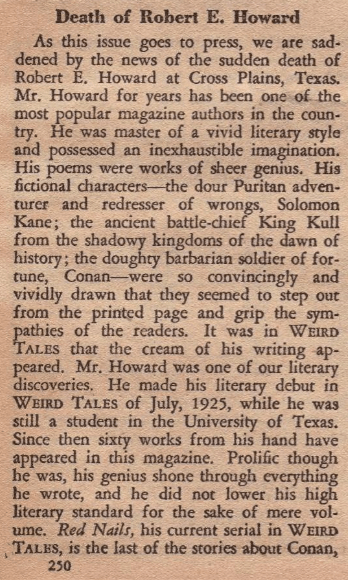

A short but heartfelt tribute from Wright and the Weird Tales staff, highlighting both his imagination as well as his dedication to his craft (something that would get lost in certain later reevaluations of his work; much like what happened with Lovecraft, there were certain parties later on interested in portraying both of them as being weirdo savants who, by accident rather than careful work, produced important and interesting fiction). I’d also point out that, right away, we begin to see certain inaccuracies creeping into the Official Biography – REH did not attend the University of Texas. He took business courses at Howard Payne College, a private Baptist college in Brownwood, TX. By the way, one of those posthumous stories promised in forthcoming issues of Weird Tales included what many consider to be his very best horror story, “Pigeons from Hell.”
The next issue of Weird Tales, v 28, n.3 October 1936, had further semi-official remembrances of Howard’s life and work published in the Eyrie, this time from his friend and voluminous correspondent HPL, as well as E. Hoffmann Price, who actually met him in person:
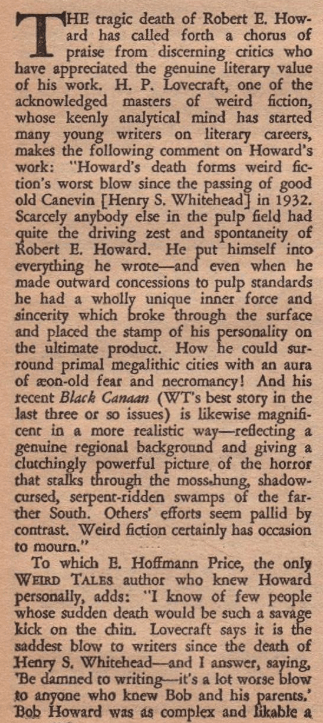
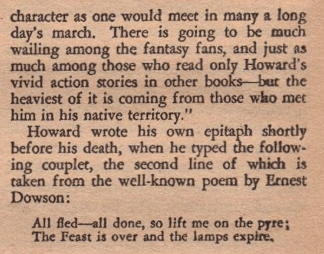
The Lovecraft excerpt is a pretty important one, I think, and sort of sets the tone for the way Howard has entered the annals of weird literature. His line about Howard having “put himself into everything he wrote” is key, and a point HPL would make over and over (it forms the center of the long in memorium he wrote for the fanzine Fantasy in their Sept 1936 issue too). The idea that Howard was deeply engaged with his writing, producing art even in spite of the commercial conditions, is high praise from someone like HPL. Too, I think both he and REH shared a deep appreciation for their roles as REGIONAL authors, people interested in their specific environments and backgrounds and what it meant for them as both people and writers. And there’s certainly something to HPL statement that Howard had a “unique inner force and sincerity” in his work – read Kuttner’s Elak story or Ball’s Rald stories and you have to admit that, no matter how fun and possibly good they are, there IS certainly something missing from them.
Also interesting is the appearance (and misattribution) of REH’s death poem there. It’s a bit of a convoluted story, and I’d point you towards Todd Vick’s biography of REH “Renegades & Rogues” for more detail, but it became a major part of REH’s mythology, a suitably literary (and barbaric) poem to mark his passing.
Even more interesting, though, is that the Eyrie is still working through fan letters from people who had written them before they’d known of REH. Take, for example, this letter from Irvin Gould of PA, asking about a map of Conan’s world:
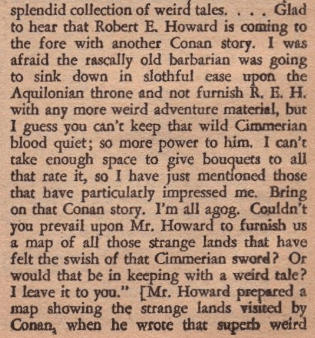

An interesting letter that sheds some light on the way people were reading and enjoying Conan – they love the hints and callbacks and history peppered throughout the stories, suggestive details about the larger world and deeper lore that imbued Howard’s writing with such vitality and sincerity, and want to know more about it! Specifically, they want a damn fantasy world map! While something like that is de rigueur in fantastic fiction now, back then it was a pretty novel request, I think. I know that there were maps in Haggard’s King Solomon’s Mine novel, for instance, and the Oz books famously had fantastic maps, but it’s fun to see people yearning for fantasy cartography because of the stories themselves and the sense of the scale and sweep of Howard’s vision. And maybe even MORE interesting is Mr. Gould’s recognition that asking for such concrete canonicity from weird fiction might not be appropriate! It’s a fun glimpse into the way READERS were engaging with both weird fiction AND Howard’s work particularly, navigating new genre conventions.
In this same issue there’s also a letter from the famously idiosyncratic fan, Gertrude Hemken. These letters from “Trudy” would become a beloved part of the Eyrie, mostly because she wrote in an absolutely delightful and totally fannish style – they’re a lot of fun, and it’s always fun to run into her in the pages of Weird Tales. Anyway, in the midst of a longer letter, she has this to say about Howard (unaware of his death, of course):
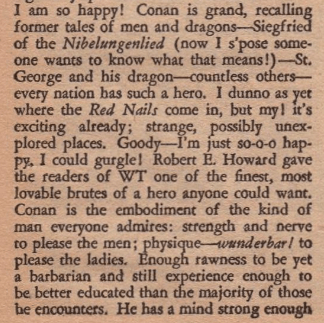

“So-o-o happy. I could gurgle!” should be the blurb they use on any and all Howard books henceforth. But it again speaks the clarity with which Howard presented Conan to the readers – he’s instantly and clearly defined, and folks like what they see!
The November 1936 issue (v. 28 n.4) includes the first fans letter reacting to the death announcement from a few issues back.

This letter’s request for a reprinting of his “best stories” as selected by the WT readership isn’t a bad one, honestly, and shows that, while the pulps were an ephemeral medium, there was a real desire to ensure that their contents lived on and were accessible to readers new and old alike. Later, in the same letter, Hopkins has an interesting thing to say:
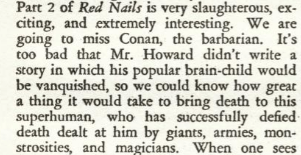
It’s an interesting daydream: “The Death of Conan the Cimmerian!” And this musing about what could’ve been, and the extension of the character’s adventures beyond the pen of the creator, is an interesting seed that we’ll see explored more in later letters.
But the desire for a collection of Howard’s work was a common one:

I wonder if Clark’s personally bound collection of Conan stories exists in some attic somewhere?
The December ’36 issues (v. 28, n.5) is mostly dedicated to wranglin’ about the covers and whether they’re too risqué or not, but that leads into an interesting letter from Robert Lowndes about the artistic representations of Conan in The Unique Magazine:
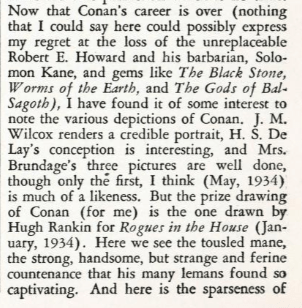

It’d be worthwhile collecting these all together and doing a careful interrogation of each, but there’s no room (or time!) here for it…maybe later. I will grab the Rankin piece that Lowndes speaks so highly of, though, from the Jan 34 issue:
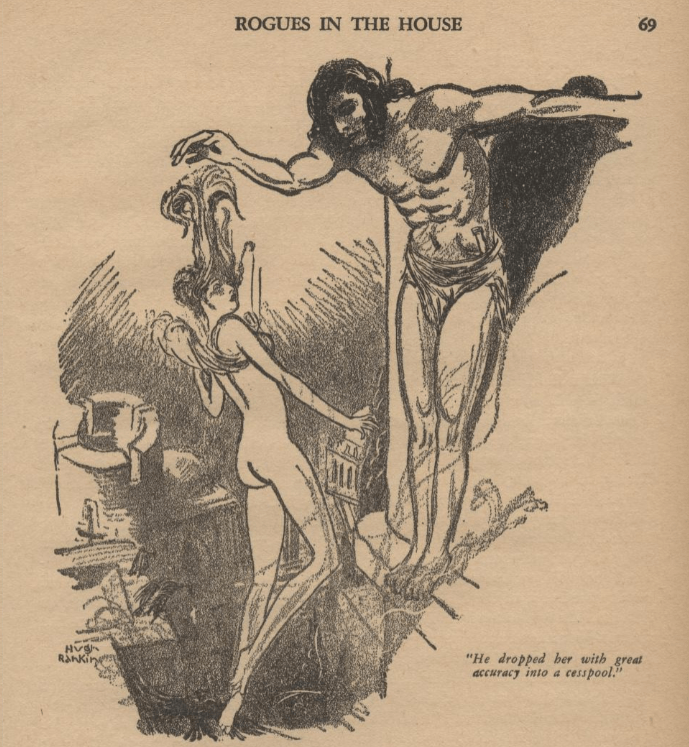
I find the sexualization of Conan by readers (and, to be fair, by Howard) hugely interesting, so the way this letter-writer highlights what it was the women found so damn hot about Conan in the stories is pretty fascinating!
I’ll just highlight one more prescient letter about REH from this issue, by the great Clark Ashton Smith:

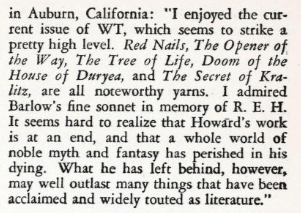
The next issue, Jan 1937 v. 29 n.1, opens with Wright reflecting on the “necrology” of Weird Tales:
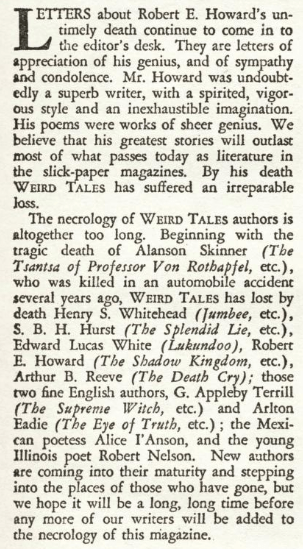
It’s a sad editorial, particularly in the way Wright’s hopes that no one else will die are pretty quickly about to be dashed. But, as he said, they’ve been getting a lot of letters about REH, and this issue includes some very fascinating ones!

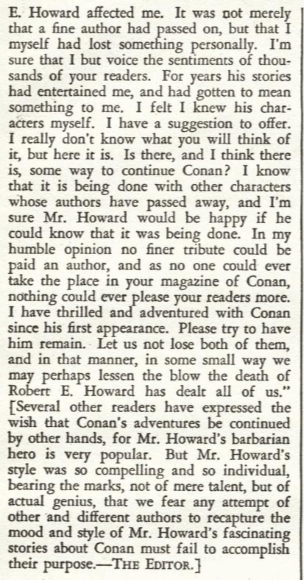
I mean, that’s fascinating, isn’t it? Can’t Weird Tales find someone else to keep writing Conan for them? What a wild question, and I can’t think of any precedent for it at all, can you? On the one hand, there must’ve been fairly widespread knowledge that some “writers” in the pulps were house names with lots of different individuals contributing stories under them (a fairly common practice in particular in the western pulps), but the idea that a writer as singular as REH could be replaced is a wild one. On the OTHER hand, though, weird fiction DID have shared universes, if not shared characters – what is Lovecraft’s Mythos but a shared world with the same gods and aliens and dark books showing up in different stories by different authors? Is that the model this letter writer is drawing from when they talk about Conan continuing without REH? I think you have to give credit to Wright here, who very clearly and definitively answers that no one can write a Conan story except Howard…something later paperback authors should’ve kept in mind, in my opinion!
This same issue includes the Ball letter that we talked about in the last Pulp Strainer blog post, and while Ball certainly isn’t asking for someone else to write Conan stories, as we discussed there is a clear expression of the desire for more stories LIKE Conan’s.
Skipping ahead a couple of issues to March ’37 (v. 29 n.3) we get another plea for a book-length collection of Howard’s work:
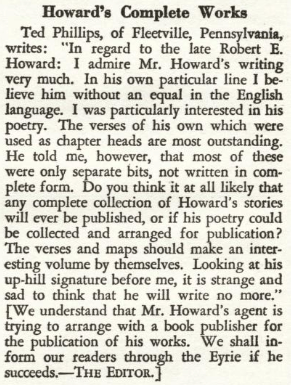
These calls for a collection of Howard’s work to be published are pretty insistent, and it’s a shame that Weird Tales got so brutally burned on their one and only book publishing adventure (The Moon Terror) that they couldn’t do something with Howard’s work. Derleth’s Arkham House would, in ’46, put out Skull-Face and Others in 1946, complete with a badass Hannes Bok cover:
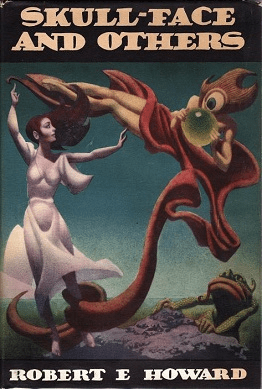
This book included some good Conan stories, but it wouldn’t be until the Gnome Press paperbacks of the mid-50s that you’d see a dedicated Conan series. Interestingly, those same Gnome Press editions would see just the sort of “Continuing Adventures of Conan” pastiche stories that (some) people were DEMANDING in there letters:
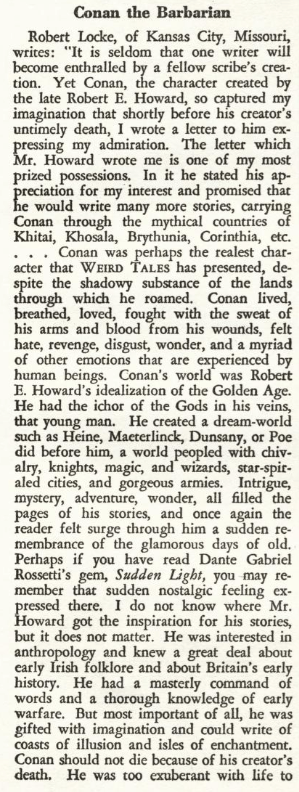
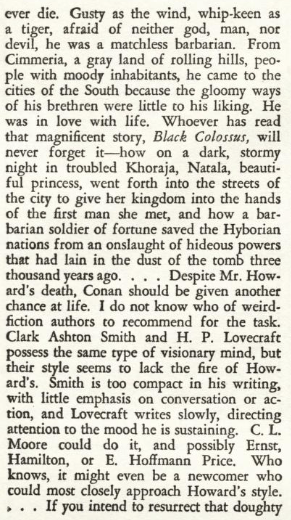
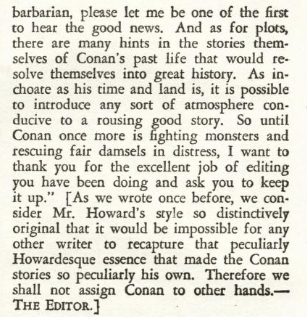
People LOVED Conan man, and that’s all there is to it. Howard had made something new and exciting, had carved out a real niche for himself in weird fiction, and the idea that there wouldn’t be any more Conan stories was a hard pill for some people to swallow. It’s interesting that everyone is explicitly couching these as more CONAN stories…they don’t want imitations, they don’t want other characters by other people, they want CONAN doing CONAN things. In some ways, then, it’s actually quite laudable that people like Kuttner tried to do SOMETHING a little different, even while trying to reverse engineer REH’s own unique approaches to his stories. Also, again, I think you have to salute Wright’s firm “nope” here too – he has a very clear aesthetic vision for weird fiction, and it doesn’t include the bloodless imitators of an inimitable writer like Robert E. Howard.
In the next issue of the Eyrie (v29 n.4) Wright publishes a letter from H. Warner Munn, a Weird Tales author famous for his “Werewolf of Ponkert” story, which was a favorite with readers, that really offers the Last Word on whether Conan should have further adventures written by other people:

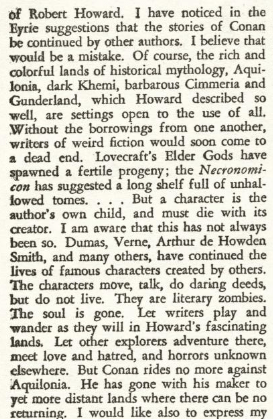
Pretty succinctly and strongly put, I’d say, and a position I support. Wright obviously thought so too, and even seems to have used Munn’s letter as the punctuation on the chapter of Official Mourning for Howard. In the next issue (May 1937, v. 29 n.5), there’s only a single, passing mention of “the late Robert E. Howard” in one of the letters, and it’s clear that they’re turning the page on the sorrowful demise of a beloved author…
…and then, in v.29 n.6, the June ’37 issue of Weird Tales:

Goddammit!
With regards to REH, I think there’s something really interesting in getting to read these letters from readers of his stories; you can see the huge enthusiasm for his work and his creations, Conan in particular, a real glimpse into the phenomenon that would become fantasy literature in general and sword & sorcery in particular. There’s a little tinge of sadness here, though – you can only hope that Howard had a sense of just how beloved his work was while he was still alive. Writers are a touchy, morose lot in general, given much to self-recrimination and disappointment, often absolutely certain that they’ve wasted their time and largely failed to achieve what they wanted to with their work. It’s something REH certainly struggled with – his letters include many gloomy reflections on his work and the struggle of writing, even when he’s arguably at the height of his career. It’s something people always talk about, but it bears repeating: if there’s someone out there whose work you like, tell ’em! Even something as simple as a nice note can mean a lot to someone, and you never know when it’ll be too late to tell them!
There’s also something extremely valuable to be had by reading these letters in the Eyrie, I think – they’re such a rich archive of READERS and their reactions to/thoughts about the stories and authors and genre as a whole. In the wake of REH’s death you really start to see the way they were ENGAGING with his work, and with Conan in particular, and it’s a real granular way to interrogate the formation of what would, eventually, become “Sword & Sorcery.” There’s ALSO a really interesting tension between what people want (more Conan!) and what they would eventually get (some pastiche-y early attempts by Kuttner, for example, and then Fafhrd & the Gray Mouser – but not in Weird Tales, of course…).
Some other stray observations – it’s interesting how CONAN focused the readers’ letters generally are, isn’t it? I mean, there’s other stuff mentioned for sure, but the Cimmerian is front-and-center, and it’s his adventures that people are clamoring for more of. Partly that’s got to be simple chronology – after all, Howard’s death is announced with “Red Nails,” one of the best Conan stories of all time, and there’d been a lot of Conan recently too, while his other characters like Solomon Kane and Bran Mak Morn hadn’t appeared for years. But there’s something about Conan’s special alchemy at work there, I think, and particularly the sense of a real, lived in, vital WORLD around him that just grabbed readers.
Finally, I’d point out how often people with talent and knowledge would point out just how inimitable Howard was as a writer. Wright is very firm in his explanations about why there’d be no more Conan stories by other people – he was a singular talent writing singular tales, and no one else could do them. Similarly, I think HPL’s oft-cited “there’s a piece of Howard in every one of his stories” is a perfect way to capture the kind of ineffable qualities of his work (and HPL’s, for that matter). It’s easiest recognized by its absence in, for instance, Kuttner’s S&S work, and really underlines the absolutely necessary quality of a writer finding their authentic voice if they want to produce art. For all the problems with Howard’s work (and there’re a lot!), the one thing you can absolutely say is that they are the products of a writer who was absolutely sincere in his efforts at communicating the things he thought were important and interesting. That he succeeded is shown by the many heartfelt letters we see in The Eyrie.

